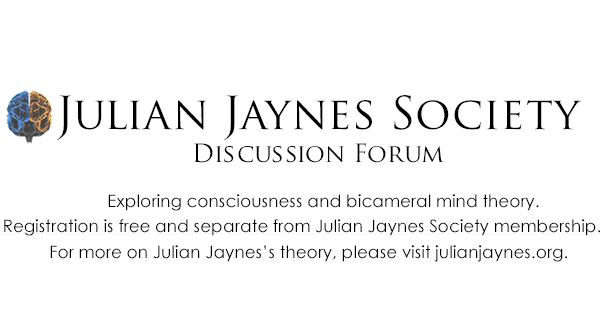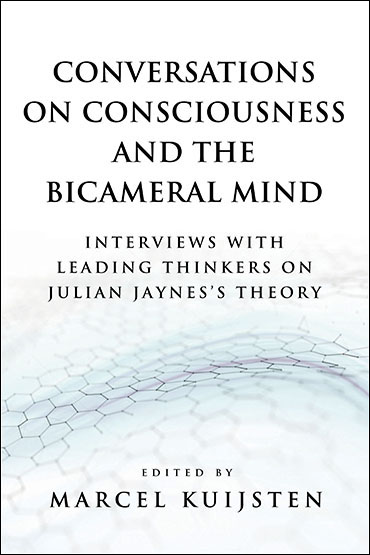Picturing Thinking: Externalization of the Images of Mind in a Darkened Space
Terryl Atkins, paper presented at The Julian Jaynes Society Conference on Consciousness and Bicameral Studies, Charleston, WV, June 2013.
Abstract: In 1979 Julian Jaynes wrote a short article called “Palaeolithic Cave Paintings as Eidetic Images” that was itself commentary on an article in the same journal by R. N. Haber on eidetic imagery, the term ‘eidetic’ referring to the retention of a visual image after the initial stimulus is removed. Those with eidetic memory are able to describe in detail, through words or drawing, something they continue to see quite literally in front of their face or in their mind’s eye. The image may fade very soon after the initial act of seeing and usually fades in sections. Haber’s contention was that eidetic memory was a faculty attributed only to some children and no longer accessible to adults. That contention has since been refuted by a greater understanding of the visual experience and mental processing of autistic savants or trauma survivors, modeling behavior in primates, developments in AI, etc. Jaynes’s argument at the time was that the Palaeolithic cave paintings found at sites such as Lascaux and Altamira were the result of eidetic memory. The points he makes in favor of this hypothesis are convincing in some cases, unconvincing in others, and in some cases supported or supplanted by information not available to him in 1979, most particularly the paradigm-shifting discovery of Chauvet Cave in 1994 and recent studies in brain, mind and consciousness.
I will be discussing the ramifications of his hypothesis in light of recent findings in relation to the externalization of imagistic experience reflected in the artwork of Palaeolithic parietal drawings and research on the experience of the eidetic in the drawings of autistic savants and the hallucinogenic in drawings of un-medicated schizophrenics. This pathological experience will be compared and contrasted to general identified artistic/creative traits and experiences.
In the plethora of recent studies conducted in the area of visual hallucination, perhaps propelled by visual degradation in a large aging population and better probing technologies, accumulating information on the interpretation of visual stimuli and the mind’s control over this interpretation based on expectations and context has shown a much greater argument for hallucinations as common experience among ordinary people rather than marginalized as psychosis. Far more prevalent in society at large, hallucinations are just ‘dealt with’ rather than brought under the thorny scrutiny of the ‘mental health’ industry. Many of the same experiential traits of schizophrenia are at the heart of the creative enterprise including but certainly not limited to the ambiguous identity of objects, divergent associations and the use of heuristics. Excessive imagination, often feared as delusional under ordinary circumstances, is the realm of the artist and the parallel tracks of schizophrenia in the human gene pool and our compulsion to draw what we retain as images or assemble as pictures in our minds eye over the millennia, I believe, touches upon several of the points Jaynes’s was making about the need (or not) for propositional language (Dennett’s term) based in consciousness to guide behavior. Though only briefly addressed in the literature around Jaynes’s original discussion, imagistic and pictorial thinking can positively support a further examination of his theory of evolution.
On a continuum of understanding that proceeds from image to picture to object, the drawings in the caves are evidence of an evolutionary trade-off that happened somewhere between image and picturing. In relation to the animal drawings in the caves as an externalization of mind, the fire enhanced undulating surface of the rock face provided the bridge that allowed these people to transfer hallucinated images into a conciliatory space, pinning down and making the image a concrete pro-nominal artifact. The images that conjure themselves in our minds are unstable entities, figurations emerging from an amorphous ground and, like dreams or hallucinations, fluctuate, dissolve and re-emerge. Unlike the stuff of the earth, images are neither concrete nor tangible. Hallucinations exist in a non-space inasmuch as they are conjured by the mind and supposedly not attached to anything one sees in reality, although that is arguable. Imaging is much like that, emerging from an environment but never quite anchored to it. The picture on the other hand is anchored to the environment in as much as it is part of a conciliatory space. Pictures are constructions, altered and interpreted images. Both imaging and picturing exist in Palaeolithic parietal drawings and I believe reflect a thinking process moving from the externalization of imagination as imagery to a pro-nominal picturing that, in the next step, allows one to name and control an unforgiving world.
My methodology is phenomenological and hermeneutic.
Please sign up or login to watch the full version in the JJS Member Area.
Terryl Atkins – Picturing Thinking: Externalization of the Images of Mind in a Darkened Space
Section for discussing lectures related to Julian Jaynes's theory of the origin of consciousness and a previous bicameral mentality.
Return to “Lecture Discussion”
Jump to
- JJS Forum
- ↳ General Discussion
- ↳ News Items Related to Jaynes's Theory
- ↳ Book Discussion: The Origin of Consciousness and Julian Jaynes Society Publications
- ↳ Myths, Misconceptions, and Fact Checks About Julian Jaynes's Theory
- ↳ Brian J. McVeigh's Random Thoughts
- ↳ Julian Jaynes
- ↳ Conferences, Events, and Local Discussion Groups
- ↳ Lecture Discussion
- ↳ Interview and Q&A Discussion
- ↳ 1.0. Hypothesis One: Consciousness Based On Language
- ↳ 1.01. Hypothesis One: Consciousness Based On Language | Subtopic: Consciousness & Dreams
- ↳ 1.02. Hypothesis One: Consciousness Based On Language | Subtopic: Consciousness in Children
- ↳ 1.03. Hypothesis One: Consciousness Based On Language | Subtopic: Consciousness and AI
- ↳ 2.0. Hypothesis Two: The Bicameral Mind
- ↳ 2.1. Hypothesis Two: The Bicameral Mind | Subtopic: Auditory Hallucinations in Normal Adults
- ↳ 2.2. Hypothesis Two: The Bicameral Mind | Subtopic: Hallucinations & Imaginary Companions in Children
- ↳ 2.3. Hypothesis Two: The Bicameral Mind | Subtopic: Hypnosis, Possession & Altered States of Consciousness
- ↳ 2.4. Hypothesis Two: The Bicameral Mind | Subtopic: Religion & the Bicameral Mind
- ↳ 2.5. Hypothesis Two: The Bicameral Mind | Subtopic: Schizophrenia
- ↳ 2.6. Hypothesis Two: The Bicameral Mind | Subtopic: The Mentality of Pre-Literate & Pre-Modern Peoples
- ↳ 3.0. Hypothesis Three: Dating the Development of Consciousness
- ↳ 4.0. Hypothesis Four: Jaynes's Neurological Model for the Bicameral Mind
- ↳ The Bicameral Mind in Fiction, Film & Popular Culture
- ↳ Information for Students


